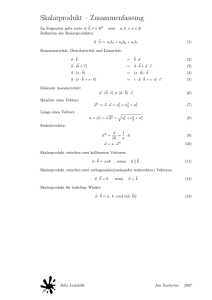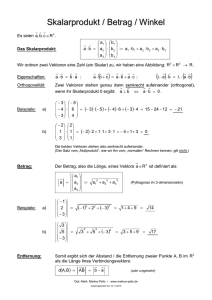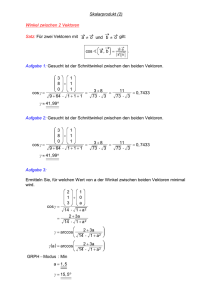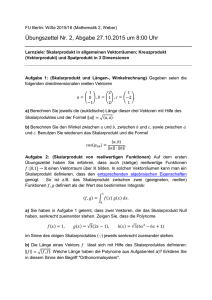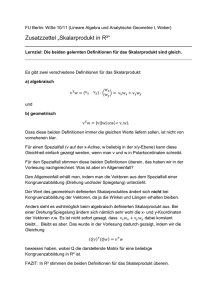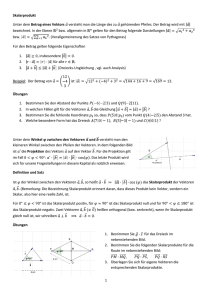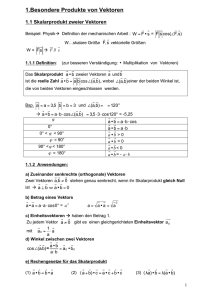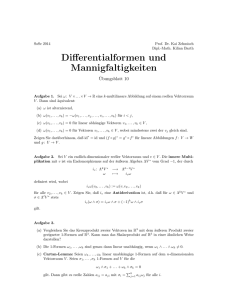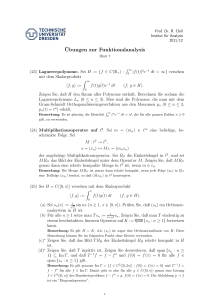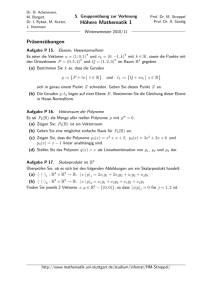2. Vorlesung
Werbung
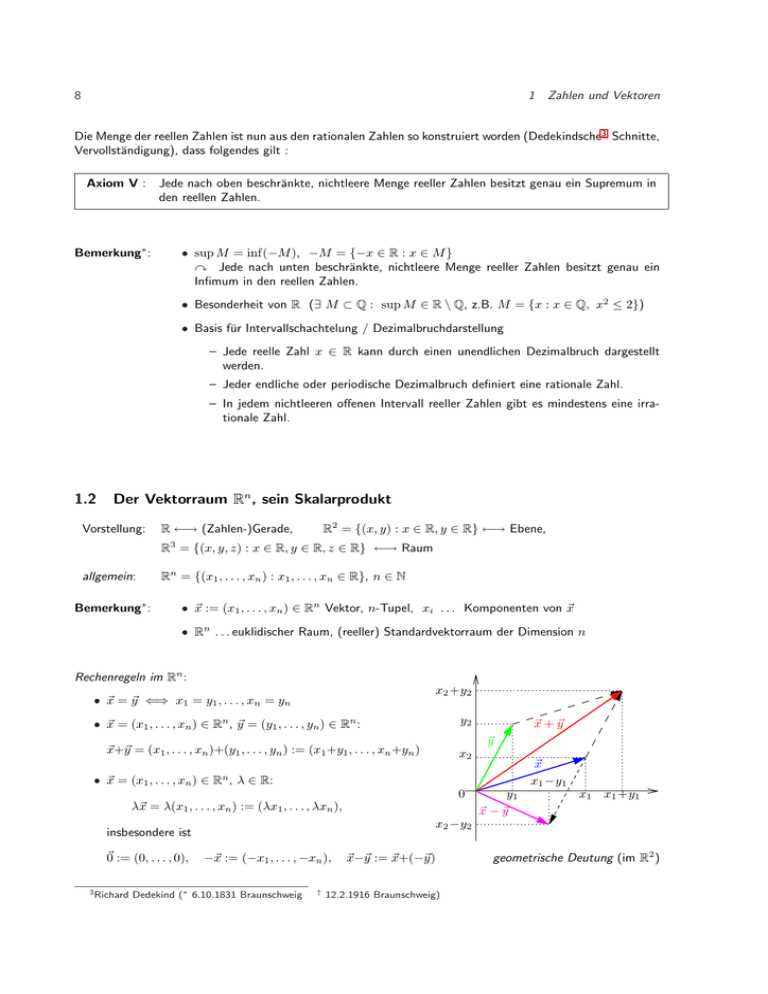
8
1 Zahlen und Vektoren
Die Menge der reellen Zahlen ist nun aus den rationalen Zahlen so konstruiert worden (Dedekindsche3 Schnitte,
Vervollständigung), dass folgendes gilt :
Axiom V :
Bemerkung∗ :
Jede nach oben beschränkte, nichtleere Menge reeller Zahlen besitzt genau ein Supremum in
den reellen Zahlen.
• sup M = inf(−M ), −M = {−x ∈ R : x ∈ M }
y Jede nach unten beschränkte, nichtleere Menge reeller Zahlen besitzt genau ein
Infimum in den reellen Zahlen.
• Besonderheit von R (∃ M ⊂ Q : sup M ∈ R \ Q, z.B. M = {x : x ∈ Q, x2 ≤ 2})
• Basis für Intervallschachtelung / Dezimalbruchdarstellung
– Jede reelle Zahl x ∈ R kann durch einen unendlichen Dezimalbruch dargestellt
werden.
– Jeder endliche oder periodische Dezimalbruch definiert eine rationale Zahl.
– In jedem nichtleeren offenen Intervall reeller Zahlen gibt es mindestens eine irrationale Zahl.
1.2
Der Vektorraum Rn , sein Skalarprodukt
Vorstellung:
R2 = {(x, y) : x ∈ R, y ∈ R} ←→ Ebene,
R ←→ (Zahlen-)Gerade,
R3 = {(x, y, z) : x ∈ R, y ∈ R, z ∈ R} ←→ Raum
allgemein:
Bemerkung∗ :
Rn = {(x1 , . . . , xn ) : x1 , . . . , xn ∈ R}, n ∈ N
• ~x := (x1 , . . . , xn ) ∈ Rn Vektor, n-Tupel, xi . . . Komponenten von ~x
• Rn . . . euklidischer Raum, (reeller) Standardvektorraum der Dimension n
Rechenregeln im Rn :
x2 +y2
• ~x = ~y ⇐⇒ x1 = y1 , . . . , xn = yn
y2
• ~x = (x1 , . . . , xn ) ∈ Rn , ~y = (y1 , . . . , yn ) ∈ Rn :
~x + ~y
~y
~x+~y = (x1 , . . . , xn )+(y1 , . . . , yn ) := (x1 +y1 , . . . , xn +yn )
x2
n
• ~x = (x1 , . . . , xn ) ∈ R , λ ∈ R:
0
λ~x = λ(x1 , . . . , xn ) := (λx1 , . . . , λxn ),
3 Richard
x1 x1 +y1
x2 −y2
insbesondere ist
~0 := (0, . . . , 0),
y1
~x − ~y
~x
x1 −y1
−~x := (−x1 , . . . , −xn ),
Dedekind (∗ 6.10.1831 Braunschweig
†
~x−~y := ~x+(−~y )
12.2.1916 Braunschweig)
geometrische Deutung (im R2 )
1.2 Der Vektorraum Rn , sein Skalarprodukt
9
Satz 1.2.1 (Vektorraumaxiome)
Seien ~x, ~y , ~z ∈ Rn , λ, µ, % ∈ R. Dann gilt:
(V1) ~x + (~y + ~z) = (~x + ~y ) + ~z
Assoziativität Addition
(V2) ~x + ~0 = ~0 + ~x = ~x
neutrales Element der Addition
(V3) ~x + (−~x) = (−~x) + ~x = ~0
inverses Element der Addition
(V4) ~x + ~y = ~y + ~x
Kommutativität Addition
(V5) (λ + µ)~x = λ~x + µ~x
(V6) λ(~x + ~y ) = λ~x + λ~y
Distributivgesetz
(V7) (λµ)~x = λ(µ~x)
(V8) 1~x = ~x
Beweis :
einsetzen & nachrechnen
nächstes Ziel : präzise (abstrakte) Fassung von Längen & Winkeln
Definition 1.2.2 Für Vektoren ~x = (x1 , . . . , xn ) ∈ Rn und ~y = (y1 , . . . , yn ) ∈ Rn ist deren Skalarprodukt
~x · ~y definiert als
n
X
~x · ~y := x1 y1 + · · · + xn yn =
xj yj .
j=1
Bemerkung∗ :
• ~x, ~y ∈ Rn y ~x · ~y ∈ R
• gelegentlich: ~x · ~y = h~x, ~y i
Satz 1.2.3 (Eigenschaften Skalarprodukt)
(i) Das Skalarprodukt ist positiv-definit, d.h. für alle ~x ∈ Rn gilt
~x · ~x ≥ 0,
und
~x · ~x = 0 ⇐⇒ ~x = ~0.
(ii) Das Skalarprodukt ist symmetrisch, d.h. für alle ~x, ~y ∈ Rn gilt
~x · ~y = ~y · ~x.
(iii) Das Skalarprodukt ist bilinear, d.h. für alle ~x, ~y , ~z ∈ Rn und λ ∈ R gilt
(~x + ~z) · ~y = ~x · ~y + ~z · ~y ,
(λ~x) · ~y = λ(~x · ~y ),
~x · (~y + ~z) = ~x · ~y + ~x · ~z,
~x · (λ~y ) = λ(~x · ~y ).
10
1 Zahlen und Vektoren
Beweis :
~x · ~x =
(ii) und (iii) einsetzen und nachrechnen, zu (i):
n
X
x2j ≥ 0,
|{z}
j=1
und
~x · ~x = 0 ⇐⇒
≥0
n
X
x2j = 0 ⇐⇒ xj = 0, j = 1, . . . , n ⇐⇒ ~x = ~0
|{z}
j=1
≥0
Definition 1.2.4 Die Länge (bzw. die Norm oder der Betrag) eines Vektors ~x = (x1 , . . . , xn ) ∈ Rn ist
definiert durch
q
√
|~x| := ~x · ~x = x21 + · · · + x2n .
Ein Vektor ~x mit |~x| = 1 heißt Einheitsvektor.
Bemerkung∗ :
• Satz 1.2.3(i) y ~x · ~x ≥ 0 y Definition sinnvoll
• Satz 1.2.3(i) y |~x| = 0 ⇐⇒ ~x = ~0
• ~x ∈ Rn , ~x 6= ~0 y ~y :=
~x
Einheitsvektor
|~x|
Satz 1.2.5 (Cauchy4 -Schwarz5 -Ungleichung)
Für ~x, ~y ∈ Rn gilt
|~x · ~y | ≤ |~x| |~y |.
Für ~y 6= ~0 gilt |~x · ~y | = |~x||~y | genau dann, wenn es ein µ ∈ R gibt mit ~x = µ~y .
Bemerkung∗ : Beweisidee: klar für ~y = ~0, also ~y 6= ~0, sei µ ∈ R beliebig y
0 ≤ |~x − µ~y |2 = |~x|2 − 2µ(~x · ~y ) + µ2 |~y |2
⇐⇒
0 ≤ |~x|2 |~y |2 − |~x · ~y |2 ⇐⇒ |~x · ~y | ≤ |~x| |~y |
~
x·~
y
µ=
|·|≥0
|~
y |2
Satz 1.2.6 (Norm-Eigenschaften)
(i) Für ~x ∈ Rn gilt
|~x| ≥ 0
und
|~x| = 0 ⇐⇒ ~x = ~0.
(ii) Für ~x ∈ Rn , λ ∈ R gilt
|λ~x| = |λ| |~x|.
(iii) Für ~x ∈ Rn , ~y ∈ Rn gilt die Dreiecksungleichung
|~x + ~y | ≤ |~x| + |~y |.
Beweis :
(i), (ii) folgen aus Satz 1.2.3, (iii) aus Satz 1.2.5:
|~x + ~y |2 = (~x + ~y ) · (~x + ~y ) = |~x|2 + 2 (~x · ~y ) +|~y |2
| {z }
≤|~
x·~
y|
4 Augustin
5 Hermann
Louis Cauchy (∗ 21.8.1789 Paris † 23.5.1857 Paris)
Amandus Schwarz (∗ 25.1.1843 Hermsdorf (Schlesien)
≤
Satz 1.2.5
†
2
|~x|2 + 2|~x||~y | + |~y |2 = (|~x| + |~y |)
30.11.1921 Berlin)
1.2 Der Vektorraum Rn , sein Skalarprodukt
11
Definition 1.2.7 Der Abstand zweier Vektoren ~x ∈ Rn , ~y ∈ Rn ist definiert durch
p
d(~x, ~y ) := |~x − ~y | = (x1 − y1 )2 + · · · + (xn − yn )2
unmittelbar aus Satz 1.2.6 folgt damit
Satz 1.2.8 (Eigenschaften des Abstands)
(i) Für ~x ∈ Rn , ~y ∈ Rn gilt
d(~x, ~y ) ≥ 0
und
d(~x, ~y ) = 0 ⇐⇒ ~x = ~y .
(ii) Für ~x ∈ Rn , ~y ∈ Rn gilt
d(~x, ~y ) = d(~y , ~x).
(iii) Für ~x ∈ Rn , ~y ∈ Rn , ~z ∈ Rn gilt die Dreiecksungleichung
d(~x, ~z) ≤ d(~x, ~y ) + d(~y , ~z).
Definition 1.2.9 Zwei Vektoren ~x ∈ Rn , ~y ∈ Rn heißen orthogonal, ~x⊥~y , falls ~x · ~y = 0 gilt.
Bemerkung∗ : Es gilt ~0 ⊥ ~x für alle ~x ∈ Rn .
Ziel : Winkel zwischen Vektoren erklären
bekannt: sin ϕ, cos ϕ für Winkel ϕ, wobei für das Bogenmaß a von ϕ gilt
a
ϕ
=
,
2π
360◦
Gradmaß
z.B.
30
π
Bogenmaß
6
◦
45
π
4
◦
60
π
3
◦
◦
90
π
2
◦
1
◦
180
360
π
2π
sin ϕ
−1
ab jetzt nur noch Bogenmaß!
a
ϕ
0
cos ϕ 1
• −1 ≤ sin ϕ ≤ 1, −1 ≤ cos ϕ ≤ 1, sin2 ϕ + cos2 ϕ = 1
• Für alle u ∈ [−1, 1] existiert genau ein ϕ ∈ [0, π] mit cos ϕ = u.
−1
Anwendung auf Vektoren: seien ~x ∈ Rn , ~y ∈ Rn mit ~x 6= ~0, ~y 6= ~0
=⇒
Satz 1.2.5
|~x · ~y |
≤1
|~x||~y |
⇐⇒
−1 ≤
~x · ~y
≤1
|~x||~y |
y
∃ ! ϕ ∈ [0, π] : cos ϕ =
~x · ~y
|~x||~y |
Definition 1.2.10 Für ~x ∈ Rn , ~y ∈ Rn mit ~x 6= ~0, ~y 6= ~0, ist der Winkel zwischen ~x und ~y , ∠(~x, ~y ),
definiert als die eindeutig bestimmte Zahl ϕ ∈ [0, π], für die gilt
cos ϕ =
~x · ~y
.
|~x||~y |
